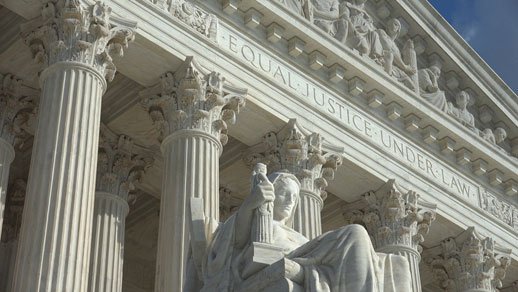
Click Here to Find Law Student Jobs on LawCrossing
What makes this legal system even more extraordinary is that it is able to cater to the diverse needs of a country and populace as big and diverse as the United States. One of the prime reasons why the legal system has been successful is a balanced and well-established chain of command: There are many separate federal courts that manage matters of federal law. Moreover, each state has its own set of courts that can cater to the specific needs of its area and people.
This article will attempt to tell the aspiring law student what the system is, how it works, what the different courts are and the fundamental basics of the American judicial system.
51 Courts:
In the United States, we have a federalist system of government. Laws are prescribed by both the federal government and the state governments. It might be said that there are 51 legal systems in the United States, one for each state and one for the federal government.
The Constitution:
The extent of the powers exercised by the federal government on the one hand and by the states on the other is determined by the nation's Constitution, which is the overriding document establishing the structure and means of operation of political authority in America.
The Constitution is based on its authors' intention to create a strong, but not wholly pervasive, central authority. To carry out this intent, they made a federal government that has been empowered to act only in specified areas. Of course, these areas are quite broad, and they are made even broader by the additional constitutional provisions that Congress can make laws that are "necessary and proper" to carry out the specified powers. This provision itself has been liberally interpreted by the courts to allow Congress to enact laws that are "appropriate" in carrying out the federal government's powers.
Specifically, the major federal powers are the powers to regulate commerce, to provide for national defense, to tax and to spend funds, to regulate foreign affairs and to enforce civil rights. Other, specific, powers include the power to coin money and regulate its value, to regulate patents and copyrights, to establish bankruptcy rules, to operate a postal service, to regulate federal elections, and to prescribe laws governing admiralty matters. It is worth noting that some of these powers coexist with comparable state powers, such as the ability to tax.
Under an amendment to the Constitution, all powers not delegated to the federal government are reserved to the states. The vastness of the federal grant of power, however, leaves only a small realm of power exclusively in the states. This power includes what is generally called the "police power," which permits the regulation of criminal conduct, but-contrary to the implication of the term-is broader. It means essentially the power to make laws governing the health, welfare, and morals of the state's citizens. Additionally, state laws govern contracts; torts personal injury, property damage, and other injuries not involving criminal laws; real and personal property; wills, trusts and inheritances; corporations; and a few other areas.
Procedural and Substantive Laws
Before we look at where the laws in this country are found, two categories into which all laws may be divided should be pointed out; procedural laws and substantive laws. All potential attorneys need to keep this distinction in mind when studying the legal concepts that they will confront in law school.
Procedural laws are those that regulate the operation of the court system itself, provide the structure and mechanics of how to sue or seek an appeal, and dictate which court to go to in the first place. These laws and regulations include those establishing the time period after a harm in which someone must sue (which is prescribed by the "statute of limitations"), which courts have the power to hear particular cases, what evidence may be introduced in the trial (and how it is to be presented), how the loser in a trial appeals, and even the proper paper size and number of pages of documents to be submitted to the court.
Thus, substantive principles deal with what one's rights are, while procedural principles deal with how one goes about enforcing them. For instance, a substantive rule of tort law is that if person A writes certain false things about person B, B may sue A. A procedural rule is that when person B commences the lawsuit, the document describing B's complaint (this document is called, appropriately, a "complaint") must include a very specific statement describing what A wrote.
Both procedural and substantive principles can make or break a lawsuit; one is no more important than the other. For instance, in the example of A and B, a court might find that what A wrote was not as bad as B claimed and so-substantively-there is no right on B's part to sue. Or the court might find that even though A's statement was clearly defamatory, B's lawyer was lazy and did not state the content of the writing specifically enough in the complaint; thus, B would be thrown out of court on procedural grounds.
Criminal and Civil Laws
Aspiring attorneys should be aware of one more distinction-between criminal laws and civil laws. Criminal laws regulate conduct in the interest of society as a whole, while civil laws regulate conduct in the interest of individuals in their private capacities. What might that mean? Here's an illustration.
Person T, a thief, steals the wallet of person V, a victim. Society, over the course of the years, has thought about similar situations and concluded that theft is not a good thing. If T wants a wallet, let him buy one; if T wants cash, let him earn it; if T wants credit cards, well, he shouldn't have left home without them.
We (society, that is, acting through the state legislature, which enacts laws) have decided that people can't simply take things from others, so we've made theft a crime. If T is caught and convicted he'll be punished-not by V, but by society (this time acting through the prosecuting attorney and the prison system). V isn't even necessary to the suit (although as a practical matter, the state may need him as a witness). The revenge, then, is the State's: People of the State of New York v. T.
Let's take another situation; this one illustrates civil law. Seller S and buyer B enter a contract under which S agrees to sell bolts to B. On the day they're to be delivered, S says, "I don't feel like shipping them. Sorry." The law calls this a breach of contract. It is a wrong, though not a criminal wrong. But think of poor B-to her, at least, bolts are important, and she didn't get what S promised. So the law-by creating a right to sue for breach of contract-has given B a remedy. The revenge is not society's, but B's-if she wishes to go to the trouble to sue. The suit here is called B v. S, and the state has no involvement except to the extent that B "rents" the courtroom, judge, sheriff, and other personnel through payment of fees.
Click Here to Find Summer Associate Jobs on LawCrossing
You've probably guessed that there's some overlap. In the first example, for instance, T's taking V's wallet is a crime. But it's also a civil wrong (the technical name is "conversion"). So T's action would result in two possible suits: State v. T for theft (criminal) and V v. T for conversion (civil), but these would be entirely separate. There would be different courts, different judges, different rules as to T's liability, and possibly different results (because there are different rules on liability).
Sources of Laws
Now, where are these laws found? Federal laws are all found in statutes-long booklets containing pronouncements by the federal Congress - or in rules or regulations adopted pursuant to the authority conferred by a statute. The statutes originate as "bills," are voted on by senators and representatives, and are then approved by the President. Statutes are not inviolable: they may be modified by courts (their language often is mystifying and must be examined and interpreted by judges). They may also be found to be contrary to the Constitution and thus declared invalid by courts. Every federal rule of law derives from a federal rule, regulation, or statute, however; the courts cannot originate a federal law. The situation in the states is different. All states have their own congresses or other legislative bodies, which enact legislation. State statutes, like the federal ones, are simply pronouncements by elected representatives of the people about how one must act or refrain from acting. And, like the federal statutes, such state legislation can require interpretation by the courts and can run afoul of the federal Constitution (as well as the state's own constitution).
Yet the situation in the states is different because state law includes the "common law," a doctrine imported from the British legal system. The common law is a body of law developed by the courts, not the legislature. It involves primarily torts, contracts, and property. If you're dealing with a case in such an area of law, the rule often will be found not in a statute but in a prior court decision involving a similar fact pattern. Statutes have largely preempted the field, and when a statute governs a matter, it takes priority over common-law rules. There are still many instances, however, in which the only source of guiding rules is the common law. Therefore, you'll have to know a little about how the system works.
A hierarchy of courts exists in each state. When confronted with a case involving one of the common-law subjects, the court will look for a decision by a higher court (i.e., one the legislature has decreed to be more powerful) in that state dealing with a similar situation. If one is located, then the lower court is bound by the common-law doctrine of stare decisis to apply the rule that the higher court stated in that earlier decision, which is called a "precedent."
The highest court in the state may change a rule in the interest of public policy, but courts tend to do so infrequently and
would much rather simply apply the rule to a fact situation as stated in the earlier decision.
The Court Systems
Just as the sources of governing law in the United States are divided into federal and state categories, so too is the court system. The federal courts are divided primarily into three levels. The lowest level of courts where the trials take place-are called federal district courts. At least one such district (although usually more than one) exists in each state. Of course, even within each federal district, there are several, and sometimes many, courtrooms and judges. At the trial level there also are specialty federal courts, such as tax courts.
One level up from the trial courts are the federal courts of appeals. If the party losing a trial in a district court wishes to pay the expenses of appealing the decision, that party may do so. The appellate court looks at what happened in the trial court, may hear attorneys for the parties argue why the decision ought to be reversed or affirmed, and will then decide whether the lower court's decision was right.
The structure of the appellate system is for the most part geographic. The country is divided into multistate areas called "circuits," each of which has a single appellate court (although, once again, a number of judges).
If a circuit court has established a rule or interpreted a statute in one way, then all district courts within that circuit are bound to apply that rule when the same fact situation arises. The concept of the stare decisis with respect to the common law will apply?
The circuit court, however, is not bound by the rules established by other circuits. In theory, there could be a different rule of law on a single subject in each federal circuit around the United States, assuming that each appellate court has addressed the same issue.
Above the appellate courts is the United States Supreme Court. The Supreme Court is required to hear only a very limited
type of case-primarily only those in which the constitutionality of a federal or state statute is called into question.
The Supreme Court, however, has discretionary power to hear a wide variety of conflicts (this is through the Court's ability to hear and grant petitions for certiorari, which is a formal appreciation by a loser in the appellate court or, in a few cases, in the district court).
Because of the huge volume of litigation in this country, the Supreme Court is able to hear only a small percentage of cases on the basis of certiorari. Generally, these cases deal with important issues of federal statutory or constitutional law and civil rights of individuals, often when two or more circuits have adopted contradictory rules.
Once again, the doctrine of stare decisis is evident. If the Supreme Court has decided an issue, the rule is binding on all federal courts throughout the country because under the Constitution, federal law takes priority over state law-it is binding on state courts as well.
The state system of courts is similar. There are trial-level courts and some form of appellate court. But often there are only two levels (unlike the federal system with its three tiers): the trial court and the state supreme court. In addition, many states have courts of "limited jurisdiction," which means that they are trial courts that are empowered to hear only certain types of cases, such as those for divorce actions only, will and estate matters only, or civil actions seeking $5,000 or less only.
Jurisdiction
"Jurisdiction" is a concept central to any study involving the court system or procedural laws. Jurisdiction refers to the extent of a court's power to act. Jurisdiction can be defined in several ways. First, geographically - for instance, an Illinois court cannot generally reach outside the state and try cases involving parties or property outside Illinois unless some connection between the person or property and the state exists.
Second, jurisdiction may be defined in terms of the type of case that a court might entertain. For example, state courts do not have the power to try federal antitrust cases. It is said that such cases are "outside the jurisdiction" of state courts.
One should not get the idea, however, that the two court systems are mutually exclusive and that state courts apply only state law and that federal courts apply only federal law. With some exceptions (such as the antitrust case just mentioned), a person can bring an action based on federal law in state court. In such a situation, the state court will be required to look to the federal rule and apply it. Similarly, it may be possible for a person with a state claim to sue in a federal court provided the jurisdictional requirements are met (these relate to the residence of the parties and the dollar amount of the claim). In this situation, the federal court steps into the shoes of the state court in the state where the federal court is sitting and applies the law of that state.
Different courts operate by different procedural laws. The entire federal system is governed by the Federal Rules of Civil Procedure. But each state court has its own set of rules that govern the operation of the court system. Some are similar to the Federal Rules, but some are quite different. For instance, while in the federal court located in New York a plaintiff starts a lawsuit by filing a complaint with the clerk, in a New York state court a plaintiff will start the suit by serving a summons on the defendant and need not even let the court know of the action until later.
Administrative Law
The court system is not the sole mechanism for applying the law in the United States. Operating largely independently of the court system is the administrative law system. As with the sources of law and the court system, there are both federal and state administrative systems. These involve bureaucratic agencies established to regulate specific areas of activity. Examples on the federal level (and there are usually similar agencies on the state level) are the Internal Revenue Service, the Federal Communications Commission, the Federal Aviation Administration, and the National Labor Relations Board. These organizations, under authority of Congress or state legislatures, establish rules to regulate the particular area of activity they are charged with.
All of these agencies have an internal dispute resolution process, which operates somewhat similarly to the court system. It may be possible, as well, depending on the issue raised, to seek redress in the court system instead of, or in addition to, following these administrative procedures.
Alternative Dispute Resolution
Because of the extremely high cost, both in terms of time and money, of suing someone and defending that suit, many conflicts that would otherwise have been settled through trials are now being resolved through a process known as alternative dispute resolution (ADR).
Arbitration is the best known form of ADR, but there are a number of variations on the process. We are even seeing ADR "courthouses" springing up, where the parties to a dispute, usually represented by lawyers, let mediators or arbitrators come to an equitable solution of a disagreement without incurring the sometimes prohibitive costs of a trial that may drag on unresolved for years on end.
Click Here to View the 2015 LawCrossing Salary Survey of Lawyer Salaries in the Best Law Firms


